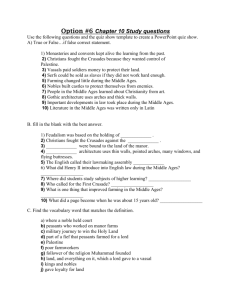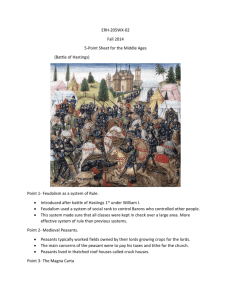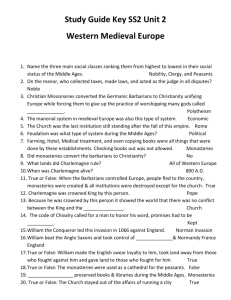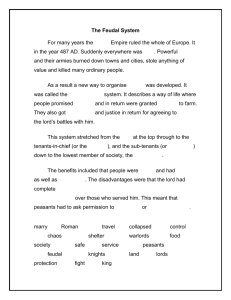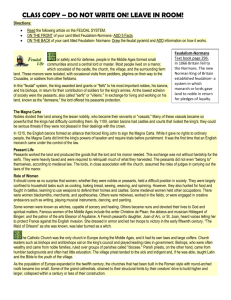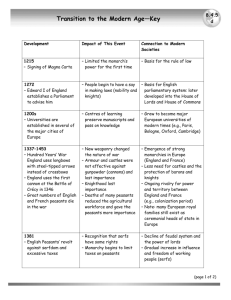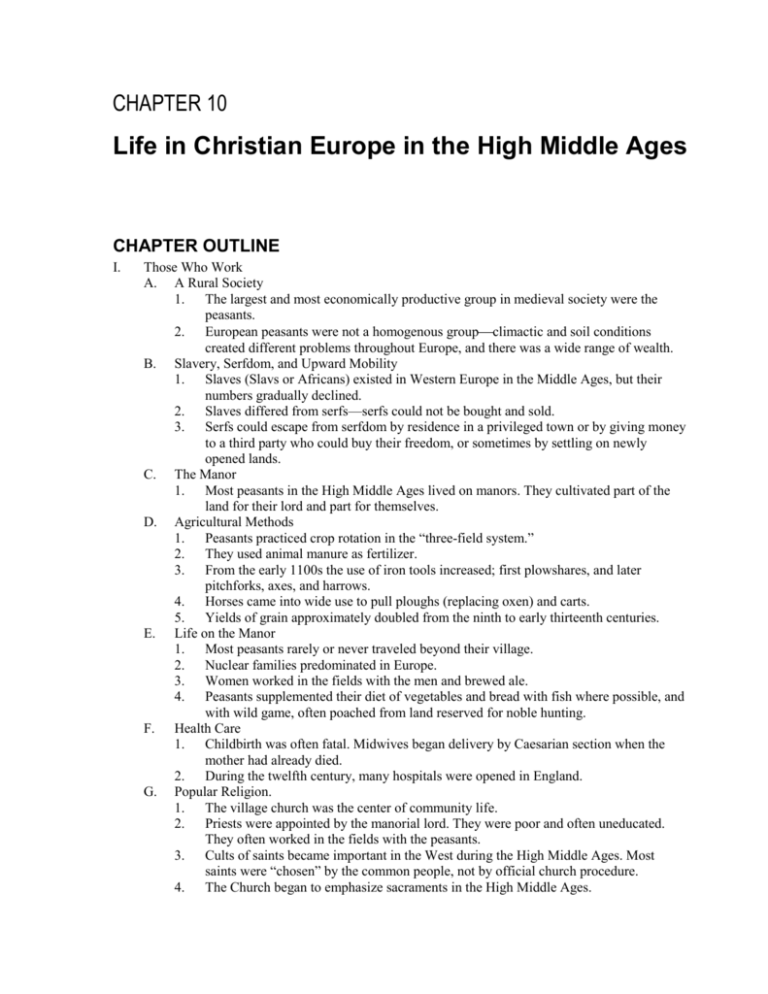
CHAPTER 10
Life in Christian Europe in the High Middle Ages
CHAPTER OUTLINE
I.
Those Who Work
A. A Rural Society
1. The largest and most economically productive group in medieval society were the
peasants.
2. European peasants were not a homogenous groupclimactic and soil conditions
created different problems throughout Europe, and there was a wide range of wealth.
B. Slavery, Serfdom, and Upward Mobility
1. Slaves (Slavs or Africans) existed in Western Europe in the Middle Ages, but their
numbers gradually declined.
2. Slaves differed from serfs—serfs could not be bought and sold.
3. Serfs could escape from serfdom by residence in a privileged town or by giving money
to a third party who could buy their freedom, or sometimes by settling on newly
opened lands.
C. The Manor
1. Most peasants in the High Middle Ages lived on manors. They cultivated part of the
land for their lord and part for themselves.
D. Agricultural Methods
1. Peasants practiced crop rotation in the “three-field system.”
2. They used animal manure as fertilizer.
3. From the early 1100s the use of iron tools increased; first plowshares, and later
pitchforks, axes, and harrows.
4. Horses came into wide use to pull ploughs (replacing oxen) and carts.
5. Yields of grain approximately doubled from the ninth to early thirteenth centuries.
E. Life on the Manor
1. Most peasants rarely or never traveled beyond their village.
2. Nuclear families predominated in Europe.
3. Women worked in the fields with the men and brewed ale.
4. Peasants supplemented their diet of vegetables and bread with fish where possible, and
with wild game, often poached from land reserved for noble hunting.
F. Health Care
1. Childbirth was often fatal. Midwives began delivery by Caesarian section when the
mother had already died.
2. During the twelfth century, many hospitals were opened in England.
G. Popular Religion.
1. The village church was the center of community life.
2. Priests were appointed by the manorial lord. They were poor and often uneducated.
They often worked in the fields with the peasants.
3. Cults of saints became important in the West during the High Middle Ages. Most
saints were “chosen” by the common people, not by official church procedure.
4. The Church began to emphasize sacraments in the High Middle Ages.
54
Chapter 10: Life in Christian Europe in the High Middle Ages
5.
Art within the church helped people to remember Bible stories, but did not impart
complex theology to them.
6. From the eleventh century the Church successfully encouraged veneration of Mary as
an intercessor with Jesus for sinners.
7. Both God and the Devil were very real for medieval people.
II. Those Who Fight
A. Political Position and Social Status
1. In some areas, such as Germany and the Île de France, the nobility was a closed caste.
In others, commoners could be ennobled.
2. A noble's freedom was limited only by his military obligations to his overlord.
Otherwise, no one had authority over a noble.
3. Not all knights were noblethe term knight had different meanings in different parts
of Europe.
4. Noble views of the peasants were complex: contempt predominated, but there were
also strains of respect (the peasants produced food; the peasants were close to God; the
peasants were “shrewd” and “cunning”).
B. Infancy and Childhood
1. Exposure of infants became less common in the High Middle Ages, but many parents
did sell or otherwise hand their children over to others because they could not feed
them.
2. Some unwanted children were donated to monasteries as oblates.
3. Noble boys were placed in the household of a relative or friend at about age seven, to
work and receive training in the military life. Training ended at age twenty-one with
the ceremony of knighting.
C. Youth
1. Young knights often traveled in bands, seeking opportunities for combat and
adventure. They were a major problem for medieval society.
2. They generally did not marry until they inherited property from their fathersoften at
age forty or older.
3. Aristocratic girls were often married to much older men at the age of sixteen or so.
D. Power and Responsibility
1. Nobles aimed to demonstrate their power and status by conspicuous display of their
retinue and their goods.
2. Nobles had to provide military service to their lord for forty days a year to serve on
guard duty at his court, to attend major ceremonies there, and so on.
3. Male nobles had to travel constantly and many died in battle. The result was that their
wives managed their estates and held a great deal of power.
4. Lateness of inheritance denied nobles constructive outlets for their energy and
exacerbated the problem of noble thuggery.
III. Those Who Pray
A. Recruitment
1. Until the thirteenth century aristocrats dominated monasticism. Many were donated to
monasteries by their parents as small children. After that the creation of new orders and
economic expansion brought more middle-class persons into the orders.
B. The Nuns
1. Abbesses most often came from the highest noble families.
2. Some, such as Hildegard of Bingen, in the Rhineland, had opportunities to display
leadership skills, scholarly acumen, and literary achievement.
C. Prayer and Other Work
1. Prayer and chanting were regular duties for monks.
Copyright © Houghton Mifflin Company. All rights reserved.
Chapter 10: Life in Christian Europe in the High Middle Ages
55
2.
D.
Monks also managed the peasants and lay brothers who did most of the actual manual
labor in the monastery.
3. Monasteries took advantage of many economic opportunities. Some, for example, bred
horses.
4. Monks also practiced medicine and served as legal advisers to nobles.
5. The Cistercians reclaimed wastelands all over Europe. They also mined and smelted
ore.
6. Some monasteries lent money, ran hospitals, served as inns, and so on.
Economic Difficulties
1. From the twelfth to fourteenth centuries many monasteries ran into financial trouble.
High living and financial mismanagement were the sources of this problem.
INTERNET RESOURCES
1.
Bibliothèque nationale de France: Images of Rural Life
(www.bnf.fr/enluminures/themes/t_3/st_3_01.htm)
2.
Bibliothèque nationale de France: Images of Medieval Medicine
(www.bnf.fr/enluminures/themes/t_3/st_3_04.htm)
3.
Tintern Abbey (www.castlewales.com/tintern.html)
4.
Rural Life: Primary Sources (www.fordham.edu/halsall/sbook1j.html#Rural%20Life)
5.
Western Monasticism: Primary Sources
(www.fordham.edu/halsall/sbook1s.html#Western%20Monasticism%20%20After%20A.D.%20900)
6.
Monastic Matrix (monasticmatrix.usc.edu)
7.
Bibliothèque nationale de France: Images of Medieval Jousts
(www.bnf.fr/enluminures/themes/t_4/st_4_03.htm)
8.
Les Très Riches Heures du Duke du Berry (humanities.uchicago.edu/images/heures/heures.html)
9.
Metropolitan Museum of Art: Arms and Armor
(www.metmuseum.org/Works_of_Art/department.asp?dep=4)
Copyright © Houghton Mifflin Company. All rights reserved.



